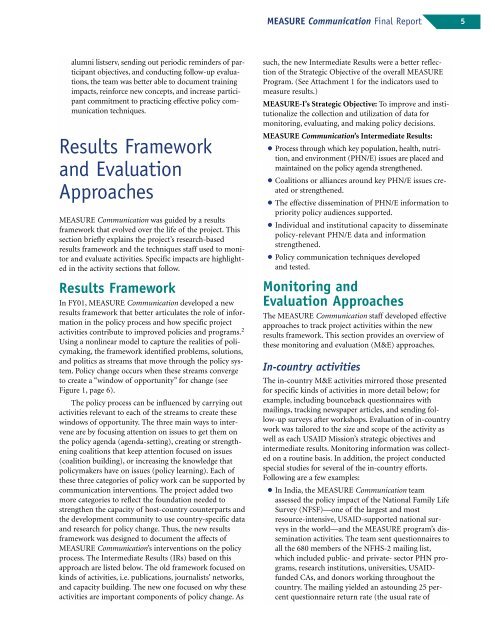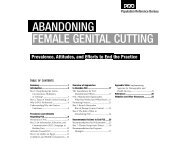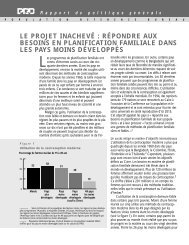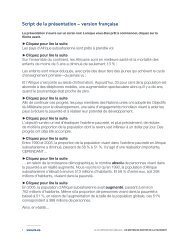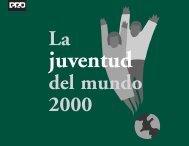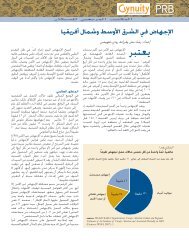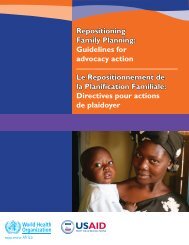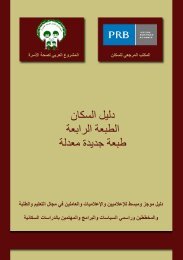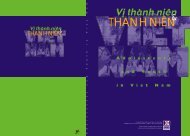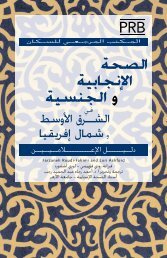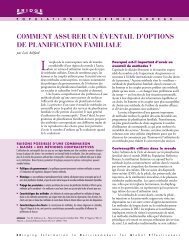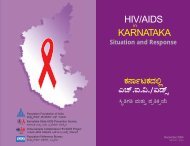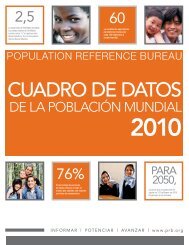MEASURE Communication Final Report - Population Reference ...
MEASURE Communication Final Report - Population Reference ...
MEASURE Communication Final Report - Population Reference ...
Create successful ePaper yourself
Turn your PDF publications into a flip-book with our unique Google optimized e-Paper software.
<strong>MEASURE</strong> <strong>Communication</strong> <strong>Final</strong> <strong>Report</strong><br />
5<br />
alumni listserv, sending out periodic reminders of participant<br />
objectives, and conducting follow-up evaluations,<br />
the team was better able to document training<br />
impacts, reinforce new concepts, and increase participant<br />
commitment to practicing effective policy communication<br />
techniques.<br />
Results Framework<br />
and Evaluation<br />
Approaches<br />
<strong>MEASURE</strong> <strong>Communication</strong> was guided by a results<br />
framework that evolved over the life of the project. This<br />
section briefly explains the project’s research-based<br />
results framework and the techniques staff used to monitor<br />
and evaluate activities. Specific impacts are highlighted<br />
in the activity sections that follow.<br />
Results Framework<br />
In FY01, <strong>MEASURE</strong> <strong>Communication</strong> developed a new<br />
results framework that better articulates the role of information<br />
in the policy process and how specific project<br />
activities contribute to improved policies and programs. 2<br />
Using a nonlinear model to capture the realities of policymaking,<br />
the framework identified problems, solutions,<br />
and politics as streams that move through the policy system.<br />
Policy change occurs when these streams converge<br />
to create a “window of opportunity” for change (see<br />
Figure 1, page 6).<br />
The policy process can be influenced by carrying out<br />
activities relevant to each of the streams to create these<br />
windows of opportunity. The three main ways to intervene<br />
are by focusing attention on issues to get them on<br />
the policy agenda (agenda-setting), creating or strengthening<br />
coalitions that keep attention focused on issues<br />
(coalition building), or increasing the knowledge that<br />
policymakers have on issues (policy learning). Each of<br />
these three categories of policy work can be supported by<br />
communication interventions. The project added two<br />
more categories to reflect the foundation needed to<br />
strengthen the capacity of host-country counterparts and<br />
the development community to use country-specific data<br />
and research for policy change. Thus, the new results<br />
framework was designed to document the affects of<br />
<strong>MEASURE</strong> <strong>Communication</strong>’s interventions on the policy<br />
process. The Intermediate Results (IRs) based on this<br />
approach are listed below. The old framework focused on<br />
kinds of activities, i.e. publications, journalists’ networks,<br />
and capacity building. The new one focused on why these<br />
activities are important components of policy change. As<br />
such, the new Intermediate Results were a better reflection<br />
of the Strategic Objective of the overall <strong>MEASURE</strong><br />
Program. (See Attachment 1 for the indicators used to<br />
measure results.)<br />
<strong>MEASURE</strong>-I’s Strategic Objective: To improve and institutionalize<br />
the collection and utilization of data for<br />
monitoring, evaluating, and making policy decisions.<br />
<strong>MEASURE</strong> <strong>Communication</strong>’s Intermediate Results:<br />
● Process through which key population, health, nutrition,<br />
and environment (PHN/E) issues are placed and<br />
maintained on the policy agenda strengthened.<br />
● Coalitions or alliances around key PHN/E issues created<br />
or strengthened.<br />
● The effective dissemination of PHN/E information to<br />
priority policy audiences supported.<br />
● Individual and institutional capacity to disseminate<br />
policy-relevant PHN/E data and information<br />
strengthened.<br />
● Policy communication techniques developed<br />
and tested.<br />
Monitoring and<br />
Evaluation Approaches<br />
The <strong>MEASURE</strong> <strong>Communication</strong> staff developed effective<br />
approaches to track project activities within the new<br />
results framework. This section provides an overview of<br />
these monitoring and evaluation (M&E) approaches.<br />
In-country activities<br />
The in-country M&E activities mirrored those presented<br />
for specific kinds of activities in more detail below; for<br />
example, including bounceback questionnaires with<br />
mailings, tracking newspaper articles, and sending follow-up<br />
surveys after workshops. Evaluation of in-country<br />
work was tailored to the size and scope of the activity as<br />
well as each USAID Mission’s strategic objectives and<br />
intermediate results. Monitoring information was collected<br />
on a routine basis. In addition, the project conducted<br />
special studies for several of the in-country efforts.<br />
Following are a few examples:<br />
● In India, the <strong>MEASURE</strong> <strong>Communication</strong> team<br />
assessed the policy impact of the National Family Life<br />
Survey (NFSF)—one of the largest and most<br />
resource-intensive, USAID-supported national surveys<br />
in the world—and the <strong>MEASURE</strong> program’s dissemination<br />
activities. The team sent questionnaires to<br />
all the 680 members of the NFHS-2 mailing list,<br />
which included public- and private- sector PHN programs,<br />
research institutions, universities, USAIDfunded<br />
CAs, and donors working throughout the<br />
country. The mailing yielded an astounding 25 percent<br />
questionnaire return rate (the usual rate of


